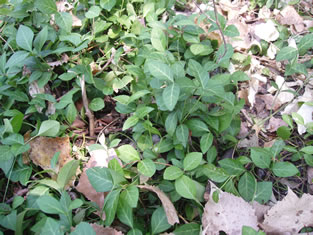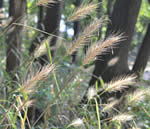- Created: 01 December 2014
- Updated: 26 April 2024
- Published: 01 December 2014
- Hits: 13552
Beneath Roanoke Park's 12' high layer of bush honeysuckle were found many patches, in some cases a continuous carpet, of Wintercreeper (Euonymus fortunei).
“What's wrong with that?” some said. “Wintercreeper is green all year.” It's “good ground cover.” WRONG.
 Click for a gallery of wintercreeper images.The problem is that wintercreeper outcompetes All native plants. ie, where wintercreeper lives, native plants die. Trees do not thrive. Without a wide variety of native plants and trees, our local insects, birds and animals cannot find the food and shelter they need to SURVIVE. Since wintercreeper and bush honeysuckle inhibit the regeneration of native plants and trees, they eventually form a monoculture and for local fauna, a food desert. Spring ephemeral wildflowers are completely killed out where wintercreeper and bush honeysuckle rule.
Click for a gallery of wintercreeper images.The problem is that wintercreeper outcompetes All native plants. ie, where wintercreeper lives, native plants die. Trees do not thrive. Without a wide variety of native plants and trees, our local insects, birds and animals cannot find the food and shelter they need to SURVIVE. Since wintercreeper and bush honeysuckle inhibit the regeneration of native plants and trees, they eventually form a monoculture and for local fauna, a food desert. Spring ephemeral wildflowers are completely killed out where wintercreeper and bush honeysuckle rule.
The goal of Roanoke Park's Ecological Restoration Plan is to maximize the ecological richness of the slopes of Roanoke Park for the benefit of park visitors and neighbors. Foreign invasive plants such as wintercreeper and bush honeysuckle are incompatible with that goal since they degrade diversity and inhibit the woods' natural self regeneration.
 Canada Wildrye on the "Valentine Slope."Park volunteers have attacked the wintercreeper in targeted areas, but the efforts have not kept pace with this aggressively spreading invasive plant. Much more remains to be pushed back and ultimately replaced, an endeavor sure to take many years. Yet within Kansas City there are models for success and reasons for hope IF WE GET SERIOUS. The Shirling Sanctuary within Swope park has been restored to better health (and more birds) by the Burroughs Audubon Society: https://www.facebook.com/AudubonKC/posts/731732742335745
Canada Wildrye on the "Valentine Slope."Park volunteers have attacked the wintercreeper in targeted areas, but the efforts have not kept pace with this aggressively spreading invasive plant. Much more remains to be pushed back and ultimately replaced, an endeavor sure to take many years. Yet within Kansas City there are models for success and reasons for hope IF WE GET SERIOUS. The Shirling Sanctuary within Swope park has been restored to better health (and more birds) by the Burroughs Audubon Society: https://www.facebook.com/AudubonKC/posts/731732742335745
In the home landescape setting, wintercreeper is only "evil" when allowed to run wild. If you have some on your property and you're keeping it trimmed and in check (preferably in an area bounded by edging or concrete), that's fine. Kudos to you for responsible wintercreeper ownership. But if you allow it to "creep" off your property, or if you allow it to grow up your trees and produce berries, Your Wintercreeper Is Doing Harm. Birds are eating the berries and bombing seeds into the park and neighboring properties. Do your neighbors and the environment a favor and cut all wintercreeper growing up trees or other vertical surfaces.
Professional Advice Against Wintercreeper, from Local to National
Alan Branhagen - Powell Gardens former Director of Horticulture.
Wintercreeper rated "#1 - severe pest"
Invasive Plants of Greater KC -Powell 2014.pdf
Larry Rizzo - Cofounder of Kansas City Wildlands, MDC Natural History Biologist (retired), Biologist with Habitat Architects.
"Wintercreeper is probably the one species that is arguably worse than honeysuckle." - personal correspondence.
“Go to Cave Spring (Historic Site) at Blue Ridge and Gregory and take a look at the woods,” Rizzo said. “It’s our version of kudzu.” - 2010 Kansas City Star article
Missouri Invasive Plant Council
A top 25 invasive plant and causing "severe environmental degredation."
https://moinvasives.org/project/wintercreeper-climbing-euonymus/
To Be Banned in Missouri?
Euonymus fortuei is included in bills advancing in the Missouri House and Senate in the spring of 2024.
https://moinvasives.org/2024/03/08/hb-2412-sb-1281/
Missouri Botanical Garden - "Midwest Noxious Weed: Do Not Plant"
https://www.missouribotanicalgarden.org/PlantFinder/PlantFinderDetails.aspx?taxonid=368044&isprofile=1&basic=Euonymus%20fortunei
Washington University - Invasive Plants of Missouri
https://sites.wustl.edu/monh/invasive-plants-of-missouri/
Leitzeger Road Ecology Center (St. Louis area)
www.litzsinger.org/research/carpenter.pdf
Research showing increased numbers and variety of tree seedlings/saplings in areas where wintercreeper and shrub honeysuckle were being managed against versus an unmanaged control area.
St. Louis Audubon Society - Bring Conservation Home program
https://sites.google.com/stlouisaudubon.org/stl-naturescaping-info-hub/bring-conservation-home-certification/residential-certification
Silver Level - Wintercreeper removed from all vertical surfaces
Platinum Level - 100% wintercreeper removed
Missouri Dept. of Conservation - "Invasive. ...heavy infestations in woodlands around St. Louis and Kansas City."
https://nature.mdc.mo.gov/discover-nature/field-guide/wintercreeper
"Wintercreeper threatens native plants and natural habitats in open-to-shady and moist-to-dry locations. It can form a dense groundcover that reduces or eliminates native plant species. It depletes nutrients and moisture for native species and can smother and kill shrubs and trees."
https://mdc.mo.gov/trees-plants/invasive-plants/wintercreeper-control
"Wintercreeper can cover the ground and vegetation and eliminate native ground cover species in mesic and dry-mesic forests. It is a serious potential threat because it spreads so rapidly and replaces spring ephemerals. The Shirling Sanctuary in Kansas City's Swope Park provides an example of a mesic forest that has been seriously degraded by the aggressive spread of wintercreeper."
State of Indiana
Wintercreeper banned, along with 43 other invasive plants by the state’s 2019 Terrestrial Plan Rule. ”Beginning April 18, 2020, no one may sell, gift, exchange, distribute, transport or introduce any of the 44 species...”
https://www.entm.purdue.edu/iisc/pdf/Terrestrial_Plant_Rule_Fact_Sheet_final.pdf
Kali Mattingly, University of Kentucky
"Recovery of forest floor diversity after removal of the nonnative, invasive plant Euonymus fortunei"
The Journal of the Torrey Botanical Society 143(2):103-116. 2016
Abstract: http://www.bioone.org/doi/abs/10.3159/TORREY-D-14-00051
National Park Service Plant Conservation Alliance
A "LEAST WANTED" page existed but is no longer hosted. See the internet archive version below. Read the Ecological Threats section.
https://web.archive.org/web/20170717021509/https://www.nps.gov/plants/alien/fact/eufo1.htm://www.nps.gov/plants/alien/fact/eufo1.htm
Invasive.org
www.invasive.org/browse/subinfo.cfm?sub=3024
"It grows across the ground, displacing herbaceous plants and seedlings..."
Invasive Plant Atlas
https://www.invasiveplantatlas.org/subject.html?sub=3024
"Euonymus fortunei has been reported to be invasive in natural areas in most of the states in the eastern half of the U.S."

